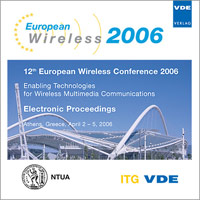Channel Impairment Effects on TPRC for Multicode V-BLAST with CD-SIC
Conference: European Wireless 2006 - 12th European Wireless Conference 2006 - Enabling Technologies for Wireless Multimedia Communications
04/02/2006 - 04/05/2006 at Athens, Greece
Proceedings: European Wireless 2006
Pages: 5Language: englishTyp: PDF
Personal VDE Members are entitled to a 10% discount on this title
Authors:
Garbo, G.; Mangano, G.; Mangione, S. (Dipartimento di Ingegneria Elettrica, Elettronica e delle Telecomunicazioni, Università degli Studi di Palermo, Italy)
Avellone, G. (Advanced Systems Technology, ST Microelectronics, Catania, Italy)
Abstract:
In third generation communication systems currently in standardization process, a number of multi-antenna schemes, derived from the well-known Bell Labs layered space-time (BLAST) approach, are being considered in order to improve performance in both communication reliability and system throughput. Among these schemes there is growing interest on schemes with feedback to aid the transmitter side (usually the Base Station) in adapting the transmission parameters, as modulation and coding rate and/or antenna/code power allocation, to the channel conditions. One of the proposed schemes is the Transmission Power Ratio Control (TPRC) for Multi-code Vertical-BLAST (with code domain serial interference cancellation, CD-SIC). The present work is motivated by observation that this scheme relies on negligibility of channel delay spread with respect to CDMA symbol length and ideal channel estimate both for data detection and feedback parameters estimation. Object of this paper is the qualitative and quantitative analysis of the effects of inter-symbol interference (ISI) and imperfect Channel State Information (CSI) on a receiving structure based on TPRC for CD-SIC. During the development of the present work, a generalized system model taking into account various channel impairments has been derived and reported.


